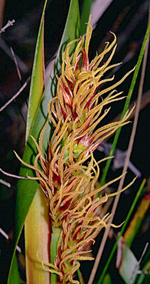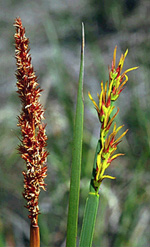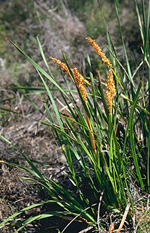 |
A predominantly southern family, Restionaceae is most diverse in Australia and South Africa, with a few species in southern South America and in south-east Asia. In Australia the main centre of diversity and richness is in south-western Western Australia, with a secondary centre in the south-eastern mainland. A few species extend to the monsoonal tropics. Members of the family are almost invariably found on poor, sandy, usually seasonally moist sites in heathlands and heathy forests.
Characteristic features of the family Restionaceae in Australia include: - sedge-like, perennial herbs with usually tough, wiry, often grey-green stems and leaves reduced to brown or black, papery, sheathing scales
- flowers small, unisexual, aggregated into spikelets with the flowers enclosed in spirally-arranged, papery or chaffy scale-like bracts
- perianth reduced to usually 6 small scales at the base of the ovary or enclosing and alternating with the 2, 3 or 6, dorsally-attached, versatile stamens
- fruit a small capsule or nut
Description
Perennial terrestrial herbs, or aquatic herbs rooted in
the substrate with their leaves emergent. Perennating by rhizomes. Vegetative
reproduction by rhizomes. Stem internodes solid or hollow, terete, strongly
flattened or rarely distinctly angular. Internal secretions not obvious.
Plants glabrous, or with simple or dendritic, non-glandular, unicellular,
uniseriate or multiseriate hairs, or peltate scales. Leaves well developed
or much reduced (i.e. to scales, etc.), alternate and spiral, cauline,
all or mostly basal, or both basal and cauline, sessile. Stipule-like
lobes absent. Lamina simple, symmetric, filiform, acicular, subulate or
linear; base attenuate; margins entire, ±flat; venation parallel,
with the midrib inconspicuous, and the tertiary venation not reticulate;
surfaces not punctate; leathery. Leaf ligule absent. Mostly with male
and female flowers occurring on the same plant or different plants, or
rarely with all the flowers bisexual. Inflorescences terminal or axillary,
consisting of spikelets, racemes or apparent panicles. Bracts present.
Bracteoles present or absent. Pollination by wind. Flowers odourless,
sessile or stalked. Floral disc rarely present. Perianth regular or irregular,
of 1 whorl only, or vestigial, or absent, with (0–) 2–3 or 6 free ±sepaloid
segments, imbricate in bud, cream, green, yellow-brown, grey or black,
without contrasting markings; inner perianth parts herbaceous or papery.
Fertile stamens 2–3 (–6), alternating with and free of the perianth segments,
free of the ovary and style, distinct from each other, all ±equal.
Anthers dorsifixed, versatile, opening inwards by longitudinal slits,
2- or 4-celled. Ovary superior and sessile. Carpels 1–3, fused; ovary
with 1–3 locules. Style terminal, single and unbranched or branching from
the base. Ovules 1–locule, sessile; placentation apical or axile.
Fruit a dry dehiscent loculicidal capsule, or an indehiscent nut; the
perianth on the maturing fruit dry and persistent. Disseminule macro-surface
featureless, or rarely with straight hairs or winged; micro-surface ±smooth
or colliculate, spinulose or papillate, white, dull. Seeds 1–3 per fruit.
Aril absent. Cotyledons 1. Embryo round, shapeless or lenticular.
Between 1998 and 2001 several papers have appeared, splitting 4 new families
out of Restionaceae (Anarthriaceae, Ecdeiocoleaceae, Hopkinsiaceae and
Lyginiaceae) and placing species formerly recognised in the genus Restio
into a number of smaller genera. Restio is not now considered to occur
in Australia.
Relevant papers are:
Briggs G.B. & Johnson L.A.S. (1998). Georgeantha hexandra, a new genus
and
species of Ecdeiocolaceae (Poales) from Western Australia. Telopea 7:
307-312.
Briggs G.B. & Johnson L.A.S. (1998). New genera and species of Australian
Restionaceae (Poales). Telopea 7: 345-374.
Briggs G.B. & Johnson L.A.S. (1998). New combinations arising from
a new
classification of non-African Restionaceae. Telopea 8: 21-33.
Briggs G.B. & Johnson L.A.S. (2000). Hopkinsiaceae and Lyginiaceae,
two new
families of Poales in Western Australia, with revision of Hopkinsia and
Lyginia. Telopea 8: 477-502."
(Note: this description has been generated from the coded data compiled
for the key. Any errors in the key data will be reflected in the descriptions.)
A treatment of the family Restionaceae has not yet been published in the Flora of Australia. It will appear in Volume 40.
Australian genera of Restionaceae (as recognised for the Flora
of Australia)
Acion
Alexgeorgea
Apodasmia
Baloskion
Calorophus
Catacolea
Chaetanthus
Chordifex
Coleocarya
Cytogonidium
Dapsilanthus
Desmocladus
Dielsia
Empodisma
Eurychorda
Guringalia
Harperia
Hypolaena
Kulinia
Lepidobolus
Leptocarpus
Lepyrodia
Loxocarya
Meeboldina
Melanostachya
Onychosepalum
Platychorda
Saropsis
Sporadanthus
Stenotalis
Taraxis
Tremulina
Tyrbastes
Winifredia

|
  |

Anarthria scabra (flowers)
Photo: D.Jones © D.Jones

Anarthria scabra (male and female flowering spikes)
Photo: M.Fagg © M.Fagg

Anarthria scabra (male flowering plant)
Photo: M.Fagg © M.Fagg

Ecdeiocolea monostachya (flowering plant)
Photo: M.Fagg © M.Fagg

|
 |
|